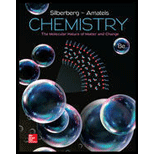
Concept explainers
Interpretation:
The balanced molecular, total ionic, and net ionic equations for the reaction between aqueous solutions of nitrous acid and strontium hydroxide are to be written and the name and formula of the salt that is formed and the spectator ions are to be identified. Also, the curved arrow for proton transfer in the net ionic equation is to be shown.
Concept introduction:
Strong acids and strong bases are the substance that dissociates completely into its ions when dissolved in the solution. They dissociate completely in water to release
Weak acids and weak bases are the substance that does not dissociate completely into its ions when dissolved in the solution. They dissociate partially in water to release
The driving force of the acid-base reaction is the formation of a gaseous product or precipitate in the reaction.
There are three types of equations that are utilized to represent an ionic reaction:
1. Molecular equation
2. Total ionic equation
3. Net ionic equation
The molecular equation represents the reactants and products of the ionic reaction in undissociated form. In total ionic reaction, all the dissociated ions that are present in the reaction mixture are represented and in net ionic reaction, the useful ions that participate in the reaction are represented.
Spectator ions are the ions that are not a part of the actual chemical change but are present in the reaction mixture to balance the charge on both sides of the reaction. They are represented in the total ionic reaction. These are the dissolved ions present in the reaction mixture.
Want to see the full answer?
Check out a sample textbook solution
Chapter 4 Solutions
Chemistry: The Molecular Nature of Matter and Change
- Ethers can be formed via acid-catalyzed acetal formation. Draw the mechanism for the molecule below and ethanol.arrow_forwardHOCH, H HO CH-OH OH H OH 11 CH₂OH F II OH H H 0 + H OHarrow_forwardDraw the mechanism for the formation of diol by starting with one pen and all in... basic conditions then acidic conditions then draw the mechanism for the formation of a carboxylic acid from your product.arrow_forward
 ChemistryChemistryISBN:9781305957404Author:Steven S. Zumdahl, Susan A. Zumdahl, Donald J. DeCostePublisher:Cengage Learning
ChemistryChemistryISBN:9781305957404Author:Steven S. Zumdahl, Susan A. Zumdahl, Donald J. DeCostePublisher:Cengage Learning ChemistryChemistryISBN:9781259911156Author:Raymond Chang Dr., Jason Overby ProfessorPublisher:McGraw-Hill Education
ChemistryChemistryISBN:9781259911156Author:Raymond Chang Dr., Jason Overby ProfessorPublisher:McGraw-Hill Education Principles of Instrumental AnalysisChemistryISBN:9781305577213Author:Douglas A. Skoog, F. James Holler, Stanley R. CrouchPublisher:Cengage Learning
Principles of Instrumental AnalysisChemistryISBN:9781305577213Author:Douglas A. Skoog, F. James Holler, Stanley R. CrouchPublisher:Cengage Learning Organic ChemistryChemistryISBN:9780078021558Author:Janice Gorzynski Smith Dr.Publisher:McGraw-Hill Education
Organic ChemistryChemistryISBN:9780078021558Author:Janice Gorzynski Smith Dr.Publisher:McGraw-Hill Education Chemistry: Principles and ReactionsChemistryISBN:9781305079373Author:William L. Masterton, Cecile N. HurleyPublisher:Cengage Learning
Chemistry: Principles and ReactionsChemistryISBN:9781305079373Author:William L. Masterton, Cecile N. HurleyPublisher:Cengage Learning Elementary Principles of Chemical Processes, Bind...ChemistryISBN:9781118431221Author:Richard M. Felder, Ronald W. Rousseau, Lisa G. BullardPublisher:WILEY
Elementary Principles of Chemical Processes, Bind...ChemistryISBN:9781118431221Author:Richard M. Felder, Ronald W. Rousseau, Lisa G. BullardPublisher:WILEY





